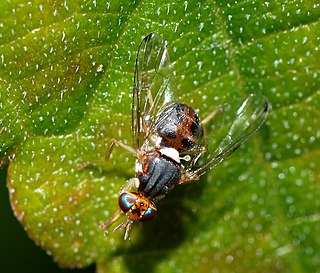
The Dacinae are a subfamily of the fruit fly family Tephritidae. Its 41 genera are distributed among three tribes:
Acrotaeniostola is a genus of tephritid or fruit flies in the family Tephritidae.
Bezzina is a genus of tephritid or fruit flies in the family Tephritidae.

Capitites is a genus of tephritid or fruit flies in the family Tephritidae.

Carpophthoromyia is a small genus of Afrotropical picture-winged flies (Tephritidae). They are usually darkly coloured and of medium size, and mostly develop in the fruit of various species of Drypetes. Carpophthoromyia is closely related to Perilampsis. There are 17 recognised species:
Dectodesis is a genus of tephritid or fruit flies in the family Tephritidae.
Migmella is a genus of tephritid or fruit flies in the family Tephritidae.
Parafreutreta is a genus of tephritid or fruit flies in the family Tephritidae.

Metasphenisca is a genus of fruit flies in the family Tephritidae. There are at least 25 described species in the Afrotropical and Oriental Regions. Of these, 20 occur in the continental Afrotropics and two are confined to Madagascar; three species occur in the Arabian Peninsula.
Oedaspis is a genus of tephritid or fruit flies in the family Tephritidae.
Platensina is a genus of tephritid or fruit flies in the family Tephritidae.
Pliomelaena is a genus of tephritid or fruit flies in the family Tephritidae.
Tephraciura is a genus of tephritid or fruit flies in the family Tephritidae.
Lethyna is a genus of tephritid or fruit flies in the family Tephritidae.
Pherothrinax is a genus of tephritid or fruit flies in the family Tephritidae.
Rhochmopterum is a genus of tephritid or fruit flies in the family Tephritidae.
Trirhithrum is a genus of tephritid or fruit flies in the family Tephritidae.
Ceratitis rosa, or commonly known as the Natal fruit fly, is an African fruit fly species from the family Tephritidae. It is considered a pest in both its native and non-native habitats. It prefers subtropical or temperate climates and the fruits that are native to these areas. It is also capable of surviving in less dry climates compared to its relative Ceratitis capitata, which is more specific in its habitat preferences. Ceratitis rosa was first described by Karsch in 1887 in Delagoa Bay, Mozambique. Soon after, in 1900, the Natal fruit fly was a recognized as a pest of orchards and fruit farmers throughout KwaZulu Natal Province, Republic of South Africa.
Ceratitis ovalis is a species of tephritid or fruit flies in the family Tephritidae. It is known from Sierra Leone.




